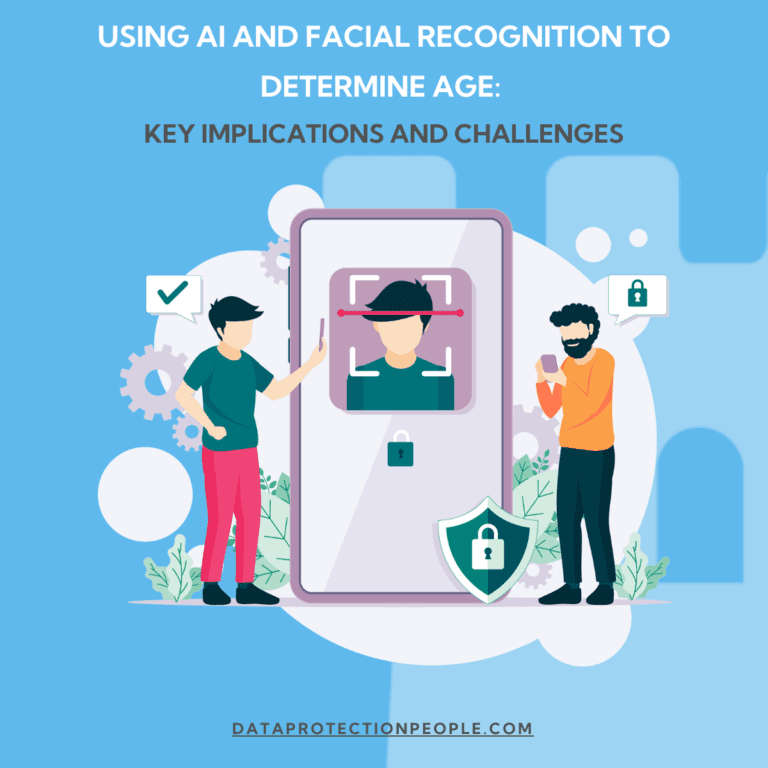Using AI and Facial Recognition to Determine Age
Check out this insightful blog on Using AI and Facial Recognition to Determine Age as we discuss the implications and the challenges of this.

Using AI and Facial Recognition to Determine Age: Key Implications and Challenges
Artificial intelligence (AI) and facial recognition technologies are constantly continuing to evolve. AI and facial recognition technologies are being used for a surprising range of applications, including determining a person’s age. From verifying age for restricted purchases to protecting minors online, age-detection technology has both compelling benefits and serious concerns. In this article, we’ll explore the potential of using AI and facial recognition for age estimation. Including, the key ethical, legal, and privacy implications that organisations and consumers need to consider.
How AI and Facial Recognition Are Used to Determine Age
AI-powered facial recognition systems analyse images of faces to estimate age by examining facial features. These features include: skin texture, and other markers that typically change over time. These systems rely on large datasets and machine learning models trained to recognise and interpret age-related patterns. Many sectors are testing or deploying this technology. This includes retail, gaming, online platforms, and social media, to verify age and restrict access to age-sensitive content and services.
Applications of Age Detection with AI and Facial Recognition
AI-driven age verification offers a range of applications that could reshape how age-restricted services are delivered:
- Age Verification in Retail: Many stores are trialling AI facial recognition to confirm age for restricted purchases like alcohol or tobacco. This approach is faster and potentially more reliable than traditional ID checks.
- Enhanced Safety for Minors Online: Social media platforms and gaming sites can use age detection to prevent minors from accessing inappropriate content. This ensures compliance with regulations like COPPA in the U.S. and the UK’s Age Appropriate Design Code.
- Content Personalisation and Marketing: Marketers may use age detection to tailor ads to specific age groups. This ensures that campaigns are more relevant and aligned with user demographics.
While the technology offers convenience and enhanced safety, it also comes with significant concerns around privacy, consent, and accuracy.
Ethical and Privacy Implications
Using facial recognition for age estimation raises several ethical and privacy concerns that organisations must address:
- Privacy Concerns: Facial recognition captures and analyses biometric data, which laws like GDPR consider sensitive. Users may not always know that their facial data is being collected and analysed, raising concerns about consent and transparency.
- Data Security and Misuse Risks: Biometric data, once collected, is a prime target for cybercriminals. If improperly stored or secured, these data can be vulnerable to breaches, posing serious risks for individuals and organisations alike.
- Potential for Bias and Inaccuracy: AI models depend on the data they are trained on. Age estimation algorithms vary in accuracy across different demographic groups, which can lead to unfair outcomes if certain age groups or ethnicities are systematically misrepresented.
Legal and Compliance Challenges
The use of facial recognition to determine age is governed by data protection laws that vary by region:
- GDPR and Biometric Data: In the EU, facial data is classified as biometric data under GDPR, meaning it requires explicit consent to collect and process. Any organisation using AI-based age detection in the EU must ensure compliance with GDPR’s strict consent and data protection standards.
- U.S. and State-Level Regulations: While the U.S. lacks a federal law specifically governing biometric data, several states, including Illinois, Texas, and Washington, have biometric privacy laws. In California, the CCPA provides privacy protections that apply to AI-driven age verification, especially when organizations collect personal data.
- UK’s Age Appropriate Design Code: In the UK, the Age Appropriate Design Code (Children’s Code) mandates that online services take steps to protect minors, which may encourage more platforms to adopt age verification but also requires transparency and strict data protection measures.
Balancing Benefits with Responsible Use
For organisations interested in using AI and facial recognition for age determination, careful consideration is essential. Here are a few best practices for responsible use:
- Prioritise Transparency and Consent: Always inform users when you collect their data for age verification, and obtain explicit consent, especially for biometric data.
- Ensure Accuracy and Fairness: Regularly test AI models to provide consistent, fair, and accurate results across all demographic groups.
- Invest in Data Security: Robust data security practices are essential to protect biometric information and prevent unauthorised access.
- Consult Legal and Compliance Experts: Compliance with GDPR, CCPA, and other relevant regulations is complex, especially where facial data is concerned. Legal guidance is crucial to ensure compliant data practices.
AI and facial recognition technology offer exciting possibilities for age verification. However, organisations must weigh the benefits against significant ethical, privacy, and compliance challenges. By implementing these practices, businesses can responsibly leverage age estimation technology while respecting users’ rights and building trust.
